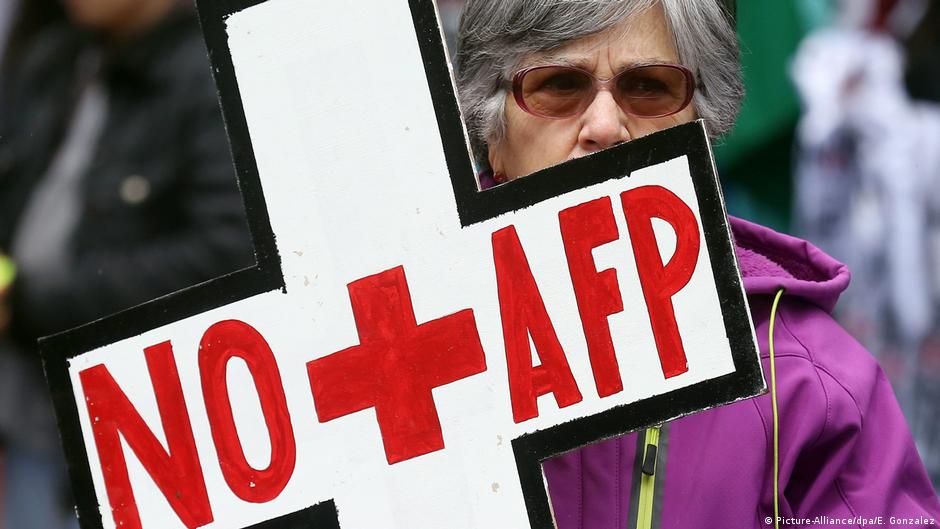RIO DE JANEIRO, BRAZIL – According to a study by the International Labor Organization (ILO), Chile’s privatized pension system model – imposed under the dictatorship of Augusto Pinochet – was copied by 29 countries between the years 1981 and 2014, of these 13 in Latin America.
Of this figure, 18 countries had reversed this system by 2018 due to the deterioration of pensions and poor results, with Chile, Mexico, Colombia, and Peru being among those that retain it and at the gates of a reform that, in the case of Chile, could occur with the arrival of the new government of Gabriel Boric.
The dissatisfaction with this individually funded system and the low pensions it offers was one of the triggers of the 2019 social outburst that led to a political agreement to draft a new constitution that would bring profound reforms to the country and end the violent protests.
In Chile, each worker is obliged to contribute 10% of their monthly salary to one of seven Pension Fund Administrators (AFP) to cover labor retirement once a woman turns 60 and a man turns 65.

CRITICISMS OF THE SYSTEM
Rodolfo Márquez, the executive coordinator of the welfare proposal of Boric’s government program, qualifies it as “a system that failed, as it did not manage to build good pensions and this is shown in the data that the average of self-financed pensions, after 40 years of exercise, is 330 dollars a month and if you go to the median, it is 193 dollars a month. Those 330 dollars represent approximately 80% of the minimum wage in Chile”.
In reaction to the increasing criticism of his government, the outgoing President, Sebastián Píñera, presented a new Universal Guaranteed Pension (PGU) bill, which was approved by the Chilean Chamber of Deputies on January 3 and passed to the Senate.
Although this initiative, which contemplates a base of US$218 for 80% of the lowest income people, is seen as an advance by Boric’s team, doubts persist as to its financing and the possible problems it could bring to the new government.
In conversation with Forbes, Márquez says that the PGU “lacks coherence” because it should be accompanied by a comprehensive reform and not be financed “by the decrease in the contribution to the pension reserve fund, the fiscal slack, and the growing revenues that we had this year in particular and which are an extraordinary event, but not permanent”.
“It is the opposite of what one recommends in terms of social security and, today, not all resources to finance that Universal Guaranteed Pension are assured, because we would go from paying 1.2 points of the GDP, which is what is spent on paying the solidarity pillar today, to spending 2.2 and this is not completely financed according to what we have been able to analyze”, he adds.
THE THREE PILLARS OF BORIC’S PROPOSAL
In this scenario, the leftist President’s team has a proposal based on three pillars:
- Non-contributory or universal pillar: it consists of a basic pension for all people, regardless of whether they contributed or not. The amount would have a base that would eventually reach US$294 per month. Fiscal resources would finance this pillar. “The Treasury currently spends 1.2 points of the GDP on the basic solidarity pension system, which is a little more than US$3.4 billion approximately. We are proposing to increase this expenditure by two additional points. This goes hand in hand with tax reform,” said Márquez.
- Contributory pillar, where mandatory contributions from workers and employers are collected: This pillar, in turn, has two components: one for savings and the other for solidarity transfers. “A third, maximum, can be used to finance this type of distribution, and the rest of the contribution rate will be saved to invest it and obtain returns collectively,” he specifies.
- Voluntary savings pillar: people who can and want to save voluntarily and, in addition to what is obligatory, have the option of choosing private institutions to manage them. And at this point, the participation of the AFPs would be contemplated, “if they so decide (…) when we talk about de-privatizing the system, we are talking about the mandatory contributory pillar, that is where we, at least in the program, propose to eliminate the AFPs”, states Márquez.
The system of this proposal would be administered by a public organism of the State, with its own assets, separated from the government of the day “so that there is no incidence in the administration of pension management”, adds Boric’s advisor.

THE ACADEMIC VIEW
In analyzing the proposal, Francisco Castañeda, director of the Business School of the Universidad Mayor, warns that the greatest weakness of the proposal of the president-elect’s team is that “a minimum profitability of the funds is not assured, except only if there is an important component of subsidies, which makes the system potentially unsustainable”.
“This is the great contingent fiscal liability that Boric’s proposal has, which may imply an important percentage of the GDP in the future (more public spending and more taxes)”, he adds.
In addition, Castañeda qualifies as complex the approval of the reform to the pension system due to the conformation of the future Parliament, divided and without a majority.
“In many countries, when pensions are generous, with high replacement rates, they are almost always financed in a significant amount by the State. It causes them to have high levels of public debt (with high-interest payments in the national budget), which also affects intergenerational equity,” continues the academic.
However, Boric’s team refutes this last point: “Public debt is issued when you do not have permanent sources of financing to cover expenses. And, in this case, the non-contributory pillar -the higher state expenditure- will be financed with the resources that will permanently be obtained from higher tax collection with the tax reform that we want to carry out. And in the contributory pillar, the system pays benefits based on the contributions of those who contribute,” says Márquez.
Pension reform is among the most urgent issues of Boric’s government, but his team contemplates that it should go hand in hand with a tax reform that should be carried out in the first instance.
On the other hand, the reform has become the second initiative with more votes to enter the Popular Participation Platform of the Constitutional Convention, a site developed so that the public can directly submit initiatives to the entity in charge of elaborating the new Chilean Constitution.
The initiative “Con Mi Plata No, Defiende tus Ahorros Previsionales” obtained 15,000 signatures for the Convention to consider it and seeks that the Constitution should guarantee the ownership of current and future funds, that they should be inheritable, and that it should be possible to choose between depositing the funds in public or private institutions.
WHAT WOULD HAPPEN WITH THE AFP IN THIS PROPOSAL?
Everything indicates that, during the first years, a reformed system will be a hybrid model between public and private, because 11 million people enrolled in the current system – seven million of them active – must make a transition, with the option of being able to choose whether to change their savings in the AFPs to a new system or leave them and only contribute the remaining years of work under the new format.
“In our proposal, the AFPs are considered to continue to exist because they are terminated as the mandatory savings mechanism, but we propose a transition that could take more than 20 years, depending on how long it takes for people to switch. They can continue to manage the stock of people who want to stay there, plus the voluntary savings pillar. In the contributory pillar, they would have no role,” warns Márquez.
For its part, the AFP association told Forbes that “they share the need to guarantee better pensions. The challenge is to find a solution that meets the demands of citizens and, at the same time, takes care of the financial and fiscal sustainability of the system, not forgetting that the labor market in Chile still has gaps”.
In this scenario, they visualize three keys to progress. In addition to establishing a Universal Basic Pension financed by the State, the AFPs believe that a voluntary savings system and a savings system based on individual accounts with freedom of choice are necessary.
“The latter responds to attributes that are important to citizens today, as are the ownership and inheritability of funds,” said the AFP Association in a written statement sent to Forbes.

WHAT ARE THE FLAWS IN CHILE’S PENSION SYSTEM?
Rather than flaws in the administration of the funds by the AFPs, José Luis Ruiz, an academic at the Faculty of Economics and Business at the University of Chile, indicates that the root of the problem is low salaries and pension gaps.
“With the AFPs, greater fiscal responsibility is introduced in the financing of pensions, since these resources exist in individual accounts. The elimination of the PFAs is due to a popular clamor to blame them for the low pensions that people receive since it is known that this is due to large pension gaps and low salaries”.
Castañeda, from the Business School of the Universidad Mayor, agrees on this point. “The low pensions (they have a 30% replacement rate) have made the system unpopular, and it lacks legitimacy among a large part of the population. But these low pensions have multiple reasons, which do not depend only on the AFP system, but also on low salaries, lack of contribution density (years of labor informality without contributions), among others”.
However, from Boric’s corner, Márquez says that the original promises of the system projected replacement rates around 70-80% by its creators. “The AFPs projected in the ’80s, on a front page of the newspaper El Mercurio, that Chileans were going to retire in 2020 with 100% of their salary, and the reality is that replacement rates are 30% down. Therefore, it is a system that lacks solidarity components and pensions are very bad; they deteriorate over time and therefore go hand in hand with the drop in profitability”.
LATIN AMERICA AWAITS
Chile was a pioneer in reforming its pension system in the early 1980s. In this sense, Ruiz points out that several countries followed the Chilean model of changing its pay-as-you-go system for one similar to that of individual capitalization.
“That is why Chile’s new experience will lead, at least, to a reflection on where their pension systems should be heading. Given the strong increase in longevity worldwide, it is necessary to have pension systems that are financed from different sources (employers, workers, and the State)”, points out the academic from the University of Chile.
In Peru and Mexico, criticism of the individually funded model is growing.
Gustavo Leal, a researcher and pension expert at the National Autonomous University of Mexico (UNAM), told the EFE news agency that Mexico’s Retirement Fund Administrators (Afore) have a “close resemblance” to the AFPs and that the first reform of the Retirement Savings System (SAR) – in force since last year – aims to increase from 34% to 82% the coverage of workers with a guaranteed pension and to raise from 56% to 97% the number of active Mexicans with the right to a pension.
For its part, Colombia is also closely following what is happening in Chile. The decision will perhaps depend on the outcome of the presidential elections. The leftist candidate, Gustavo Petro, has mentioned a possible reform of the current mixed system.
With information from Forbes

